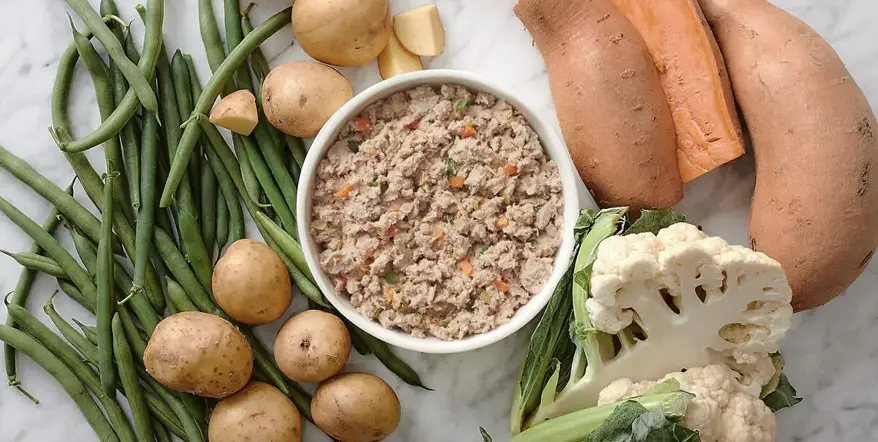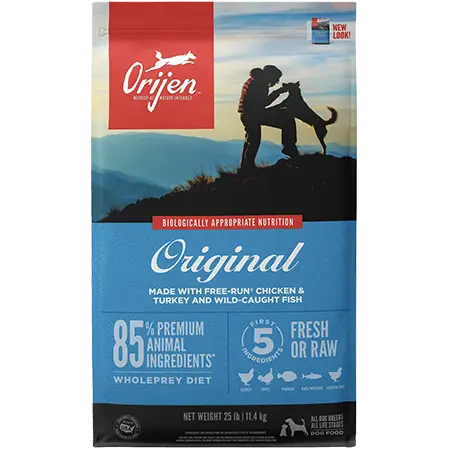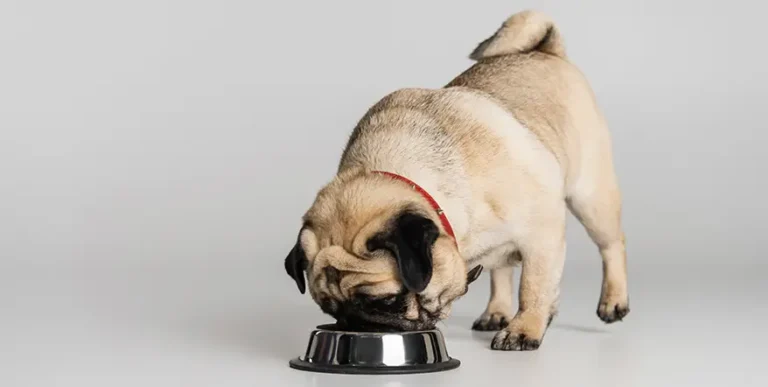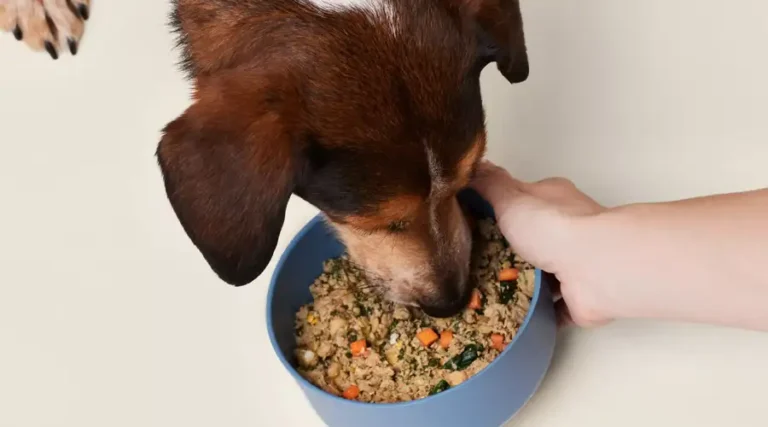15 Best Dog Foods: Our 2023 (Extremely) In-Depth Guide to Dog Food
Quick Guide
- What Is The Best Dog Food?
- Different Types of Dog Food
- Different Types of Special Diet Foods
- Nutritional Requirements Based on Breed Size
- What is the Difference Between the Worst and Best Dog Food?
- 6 Tips to Determine a Good Dog Food by the Label
- Here are the Remaining 10 Best 5-Star Dog Foods:
- Solid Gold Mighty Mini Toy & Small Breed Chicken, Chickpea, & Pumpkin Dry Food
- Wellness CORE Grain-Free Small Breed Turkey & Chicken Dry Food
- Now Fresh Grain-Free Large Breed Turkey, Salmon, & Duck Dry Food
- Wellness Complete Health Deboned Chicken w/ Barley Senior Dry Food
- Merrick Texas Beef w/ Sweet Potato Grain-Free Dog Food
- Canidae PURE Lamb w/ Pea Limited Ingredient Dry Food
- The Farmer’s Dog Beef Recipe
- Castor & Pollux Organix Chicken & Sweet Potato Grain-Free Dog Food
- Zignature Zssential Formula Grain-Free Wet Food
- The Honest Kitchen Whole Grain Chicken Dehydrated Dog Food
- Our 2023 Dog Feeding Guide:
- How many cups are in a pound of dog food?
- Best Dog Food – Summary
Choosing the best dog food is a deceptively easy, yet complex decision that many dog owners find themselves contemplating at some point in their life.
If you really want to give your dog the best, then the fresh, super-premium brands stand far above the rest. If you’re working with other criteria like budget, health considerations, and food storage then the choices become instantaneously more complicated and overwhelming.
If that’s the case then it’s best to refine your search more specifically. “What are the healthiest dog foods?” or “What is the best dog food for my Yorkie with allergies?” are better queries that will result in a more targeted, higher quality recommendation closer to the ideal product for your dog’s unique nutritional needs.
This article is designed to provide you with an in-depth guide to understanding the benefits of different food forms and ingredients, and offer multiple healthy suggestions from a variety of brands and recipes that are all good for their own reasons.
What Is The Best Dog Food?
Ollie Fresh Turkey Dish w/ Blueberries
Editor’s Choice
Ollie dog food is a fresh-frozen soft meal tailored to your dog’s weight, activity level and food sensitivities. It is a super-premium recipe made from human-grade ingredients – chock full of healthy proteins and nutritious vegetables. Also available in Chicken, Lamb, Pork, and Beef.
50% Off Code : EASYPET
Ollie Fresh Turkey Dish w/ Blueberries
| Our Rating | 6 Stars |
| Average Price | $6.24/day |
| First 5 Ingredients | Turkey, Kale, Lentils, Carrots, Turkey Liver |
| Guaranteed Analysis | Protein (11% min), Fat (7% min), Fiber (2% min), Moisture (72% min) |
| Type | Fresh |
| Pros | Delivered fresh to your door, Catered to your dog’s calorie needs, Made with high-quality ingredients, No artificially preservatives, Made in the USA |
| Cons | Very expensive, Must be kept refrigerated/frozen |
| Best For | Toy Breeds, Weight Control, Sensitive Stomach, Picky Eaters |
50% Off Code : EASYPET
Ollie Fresh Turkey Dish w/ Blueberries
If you’re looking for a human-grade dog food to buy for a dog, you may want to consider a fresh food option like Ollie. This service delivers freshly prepared meals to your door on a weekly basis. All meals are prepared using whole, restaurant-quality ingredients to ensure the highest quality nutrition for your dog with no freezing or preservatives.
When you sign up for the service, you fill out a profile for your dog which enables the company to create a custom recipe based on your dog’s calorie needs then the food is sent to you fresh for storage in your own fridge or freezer. Because the food is prepared fresh with gentle cooking methods, all of the nutritional integrity is retained for a wholesome meal.
50% Off Code : EASYPET
Orijen Original Turkey, Chicken, & Fish
Best Dry Dog Food
This original recipe is formulated for all life stages and made with 85% poultry, fish, and egg ingredients with 15% fruits, vegetables, and botanicals – no grains, potatoes, tapioca, or plant protein concentrates. It offers a full 38% protein from numerous premium animal sources with 18% crude fat. It also contains beneficial supplements such as freeze-dried organ meats, chelated minerals, and probiotics.
$20 Off 1st Order of $49+ at Chewy
Orijen Biologically Appropriate Original Recipe Dog Food
| Our Rating | 6 Stars |
| Average Price | $4.00/lb |
| First 5 Ingredients | Chicken, Turkey, Salmon, Whole Herring, Chicken Liver |
| Guaranteed Analysis | Protein (38% min), Fat (18% min), Fiber (4% min), Moisture (12% min) |
| Type | Dry |
| Pros | First 5 ingredients are whole meat proteins, |
| Best For | Giant Breeds, Weight Gain, High Protein, Picky Eaters |
50% Off Code : EASYPET
50% Off Code : EASYPET
- American Journey Chicken & Brown Rice Dry Dog Food
- Taste of the Wild High Prairie Dog Food
- Nature’s Variety Instinct Raw Boost Kibble + Raw Food
- Solid Gold Mighty Mini Toy & Small Breed Dry Food
- Wellness CORE Grain-Free Small Breed Dry Food
- Now Fresh Grain-Free Large Breed Dry Food
- Wellness Complete Health Senior Dry Food
- Merrick Grain-Free Dog Food
- Canidae PURE Limited Ingredient Dry Food
- Castor & Pollux Organix Grain-Free Dog Food
- The Farmer’s Dog Fresh, Human-Grade Beef Dog Food
- Zignature Zssential Formula Grain-Free Wet Food
- The Honest Kitchen Dehydrated Dog Food
American Journey Chicken & Brown Rice Dry Dog Food
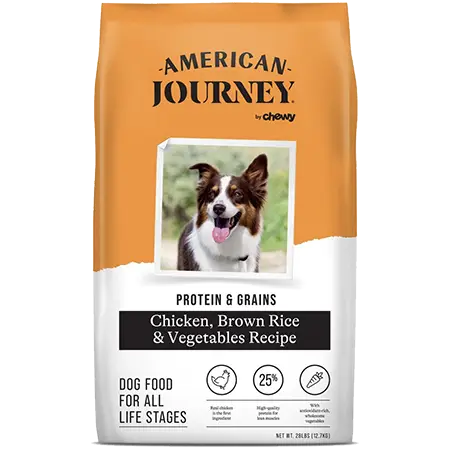
Our Most Affordable: Produced and sold by Chewy, the American Journey brand of dog food is an affordable option that still offers good quality which makes it one of the best foods if you’re on a budget. American Journey offers a wide variety of products, including grain-free options made with digestible carbohydrates like sweet potatoes.
Their chicken and brown rice recipe is one of their most popular, made with high-quality and nutritious ingredients like deboned chicken, chicken meal, brown rice, chicken fat, and fresh fruits and vegetables. It also contains chelated minerals for maximum nutrient absorption.
- Pros: Affordable but high in quality, rich in protein and healthy fats, made with nutritious ingredients, fresh fruits and vegetables, digestible whole grains, chelated minerals
- Cons: Some recipes are not grain-free, no probiotic supplements
Taste of the Wild High Prairie Roasted Bison + Venison Dog Food

Most Popular Pick: If you’re looking a premium food dogs like Taste of the Wild is a very popular brand. Taste of the Wild uses real roasted meats in protein-rich formulas that are free from grains, fillers, and artificial additives. Their most popular recipe is the Taste of the Wild High Prairie Puppy formula which features real buffalo as the first ingredient with other proteins like bison, roasted venison, and beef to support strong muscles. This recipe also contains plenty of healthy fats as well as beneficial supplements like antioxidants from real fruits and vegetables, chelated minerals, and dried fermentation products which act as probiotics for healthy digestion.
- Pros: Real roasted meats, rich in protein and healthy fat, grain-free, no fillers or artificial additives, mimics a dog’s natural diet, supports skin and coat health, probiotics, chelated minerals
- Cons: Some dogs are sensitive to beef, contains some plant protein concentrates
Nature’s Variety Instinct Raw Boost Chicken Kibble + Freeze-Dried Raw Food

Our Best Dry Pick: When it comes to foods dogs like, dry food is usually the way to go, and Nature’s Variety Instinct Raw Boost is an excellent option. This dog food consists of high-quality kibble mixed with bits of freeze-dried meat to provide a boost of nutrition and natural flavor. Each recipe features a different protein, but they are all rich in protein and healthy fats. This line of products is free from grains, potatoes, and low-quality fillers as well as by-products and artificial colors. Plus, it is made in the USA and contains all the supplements your dog needs for healthy digestion and balanced nutrition.
- Pros: High-protein kibble and freeze-dried raw pieces, real animal proteins, rich in healthy fats, free from grains and fillers, no artificial additives, made in the USA, beneficial supplements
- Cons: Very expensive, some recipe contain chicken ingredients (some dogs are sensitive)
Now that you’ve seen a preview of some of our dog food reviews, we’re going to start getting into the nitty gritty of it. First, we’ll review the different types of dog food and their benefits – you may be surprised to learn there’s more than just dry food and wet food! From there, we’ll explore special diets and nutritional requirements based on breed size.

Different Types of Dog Food
All it takes is a quick stroll down the dog food aisle at your local pet store to realize that there are many different options to choose from. Not only do you need to pick a brand, but you have to think about what type of food is right for your dog.
Here is a quick overview of the different types of dog food and their benefits so you can make a smart decision in choosing a food to buy for a dog:
Dry Food
Also known as kibble, dry dog food is the most common type of commercial food. Most dry foods are made by combining raw ingredients, cooking them, and grinding or blending them together into a homogenous product that is then extruded into small bite-sized pieces. Quality varies greatly depending on the process used to create dry food and, of course, the quality of the ingredients themselves, but dry food is usually the most affordable option and offers a longer shelf-life than other types of food.
In addition to being affordable and convenient to feed, dry food offers dental benefits as well. The act of chewing dry kibble helps scrape plaque and tartar from your dog’s teeth. If your dog has a specific health problem or dietary requirement, you’re also more likely to find it in dry food form than as a wet food – there is simply a greater variety of dry foods to choose from. Whether you’re looking for a specific type of protein or a product free from a specific ingredient, a dry food for it probably exists.
Wet Food
There are several different types of wet food, but it usually comes in cans or pouches. The biggest difference between wet food and dry food is, of course, the moisture content. Dry food usually has a moisture content around 10% whereas wet food may be as high as 87% moisture. Wet food may also have a higher percentage of protein than dry food as well as higher levels of fat. The higher percentage of these ingredients may improve the flavor, but it also increases the caloric concentration of the food.
When shopping for wet food, you need to be careful about the ingredients used to thicken or bind the ingredients as well as artificial additives like colors, flavors, and preservatives. You should also keep in mind that many wet food products are sold as food toppers – they are designed for supplemental feeding and not your dog’s staple diet. The shelf-life of wet food is very long until the package is opened. At that point, it generally only lasts 3 to 5 days in the refrigerator.
Prescription Food
This type of dog food is typically designed to meet specific dietary requirements based on certain health problems. These are the dog foods you’ll find at your vet’s office and may only be able to purchase with a prescription. At first glance, a food designed to treat your dog’s specific dietary needs may sound like a good idea, but the reality of prescription dog food is not so simple.
Not only is prescription food often much more expensive than regular kibble, but the quality is also much, much lower for popular brands like Hill’s Science Diet, Purina, and Royal Canin. If you take a look at the ingredients list for these products, you’ll see a high concentration of corn, wheat, and soy ingredients as well as by-products and fillers. Some reputable dog food manufacturers offer their own lines of prescription-style food (like Blue Buffalo BLUE Natural Veterinary Diet), but for the most part prescription dog food is best avoided.
Freeze-Dried Food
Though it may sound like the two terms are interchangeable, there is a difference between freeze-dried food and dehydrated food. Dehydrated food has had the moisture removed whereas freeze-dried food is frozen first and then the moisture is removed by slowly raising the temperature. The result is a dehydrated product that still retains much of its original nutritional integrity.
Like dehydrated food, freeze-dried food typically requires rehydration before feeding.
When it comes to freeze-dried food, products can be either cooked or raw. Many high-quality kibbles these days are supplemented with freeze-dried raw bits or sprayed with a freeze-dried raw coating at the end of the production process. Both options are very flavorful for dogs while also being high in nutritional value. Plus, there is the benefit that they don’t require artificial preservation.
Human-Grade Food
The term human-grade simply means that the ingredients used are deemed fit for human consumption but, when it comes to dog food, the term “human-grade” refers to two things.
First, a dog food must be made with human-grade ingredients in order to qualify.
Second, it must be produced in a human food manufacturing facility. If the product is made with human-grade ingredients but produced in a dog food manufacturing facility, the packaging can state that the product is “made with human-grade ingredients” but cannot go so far as to label the entire product human-grade.
Dehydrated Food
Technically speaking, dehydrated dog food is a type of dry food, though the process to make it is different. Most dehydrated food is made by removing the moisture from the raw ingredients rather than cooking them. Dehydrated foods often need to be rehydrated before feeding, but they usually contain more of their original nutrient content than most foods. The dehydration process also negates the need for preservatives, which is a bonus. The biggest downside with dehydrated food, aside from the need to rehydrate it, is that it is usually very expensive.
Fresh and Frozen Foods
Many veterinarians agree that fresh food is the closest to a dog’s natural evolutionary diet. Fresh food can be either cooked or raw, and it comes in both refrigerated and frozen forms. The benefit of this type of food is that the quality of the ingredients is generally very high and, particularly for raw varieties, the original nutritional integrity of the raw ingredients isn’t compromised by processing. Plus, refrigeration or freezing negates the need for many preservatives.
Though fresh and frozen foods offer superior nutritional value, they are typically very expensive. As fresh food for pets gains popularity, there are many companies out there that deliver fresh dog food right to your door – some will even create a custom recipe for your dog. Again, these products are very expensive, but they do offer unique benefits such as improved digestion and nutrient absorption, healthier skin and coat, and relief from food allergies and sensitivities.
As if that weren’t enough, dog food can be further broken down into different categories for different special diets. Keep reading to learn more.

Different Types of Special Diet Foods
Though all dogs have the same basic requirements for protein, fat, and essential nutrients, some dogs have special dietary requirements based on their age, their breed, or some kind of health condition. For example, if you are trying to get your dog to gain weight, you might switch him to a high-calorie or a high-protein diet. There is a dog food out there for every diet!
Here is an overview of the different types of special diets you may come across as you start shopping for the best dog food. Keep in mind that some of these foods are for specific health problems, so check with your veterinarian before switching your dog to one of these special diet foods:
Flax-Free
Flaxseed and flaxseed oil are commonly used in dog food as a supplementary source of omega fatty acids. Though flax is generally considered beneficial for dogs, there are some concerns. For example, there is some doubt about dogs being able to metabolize alpha-linolenic acid (ALA), a type of fat that can be converted into omega-3 fatty acids. Because dogs may not be able to metabolize ALA, flaxseed is a less biologically valuable source of fat than other options like salmon oil.
Another concern with flaxseed is the fact that the raw plant contains cyanogenic glycosides which, in large amounts, could lead to cyanide poisoning in dogs. Symptoms of flax poisoning in dogs include vomiting, diarrhea, shortness of breath, rapid heartbeat, weakness, seizures, and paralysis. Due to these concerns, you may want to consider a flax-free dog food for your dog.
Gluten Free
Gluten is a type of protein found in wheat, barley, and rye. In pet food, gluten acts as a binder to keep the food together, so it maintains its shape. Though gluten is technically a protein, it is plant-based which limits its bioavailability to your dog. There is also the potential that your dog could develop an allergy to gluten. It is more likely, however, that he develops an allergy or sensitivity to grains in general, though that only happens in about 1% of dogs.To find the a dog food that is gluten-free, the easiest thing to do is find a grain-free recipe. Though not all grains contain gluten, if a product is grain-free there is a good chance that it is gluten-free as well. Unless your dog has been diagnosed with a gluten or grain sensitivity, it may not be worth the hassle to find a gluten free food.
GMO-Free
Genetic modification isn’t all bad. It can be used to make crops resistant to drought or to encourage them to grow in a place where they are not native. In dog food, however, GMO ingredients can be harmful. Unfortunately, there is no way to know if the grains in your dog’s kibble are genetically modified, though we do know that over 80% of the corn and soy used in pet food and animal feed has been genetically engineered.
The long-term effects of consuming GMO ingredients are yet to be seen, but there is research linking GMO ingredients to allergies, toxicity, and other health problems. Just because there isn’t definitive evidence that shows GMO ingredients are not safe for long-term consumption doesn’t mean that they are. Keep in mind that these studies are based on the effects of GMO ingredients on humans – the effects on dogs are unclear. Plus, pet foods are less regulated than human foods, so there is a good chance that your dog’s kibble contains GMO ingredients unless it is clearly stated that it doesn’t.
Grain Free
A large percentage of dog owners prefer to feed their dogs grain free food, but what are the benefits? Grains include ingredients like wheat, corn, barley, and rice which are not inherently bad for your dog. Low-quality fillers made from grains like wheat and corn are best avoided, but whole grains offer good digestibility and nutrition for more dogs.
If your dog is sensitive or allergic to grains, you may want to look into grain free dog food. Grain free food is usually made with starchy vegetables, beans, or legumes. Because some of these ingredients are plant-based sources of protein, you need to be mindful of that – choose a grain-free recipe that contains plenty of animal protein to ensure that your dog’s needs are being met. Fortunately, finding grain free food is very easy, and there are many brands to choose from.
High Protein
Proteins are made up of amino acids, and there are 22 that your dog requires. Of those 22, 10 are considered “essential” amino acids because his body cannot synthesize them on his own. Protein is the most important nutrient for dogs because it helps him develop strong muscles and to maintain lean mass. If you’re looking for a dog food to help your dog build more muscle or to simply gain weight, a high-protein recipe may the best food for your dog.
When shopping for high protein dog food, you need to be concerned about the quality of the ingredients. Animal-based proteins are best for dogs because they are complete proteins – this means that they contain all of the 10 essential amino acids. Some plant foods contain protein but they are not complete sources, so make sure most of the protein in your dog’s high protein dog food comes from animal sources so he can digest and utilize it properly.
Limited Ingredient
A limited ingredient diet or LID is simply a type of dog food made with a lower number of main ingredients. These dog foods are also frequently made with novel sources of protein and carbohydrate, ideally a single source of animal protein. Limited ingredient dog foods are good for dogs who have food allergies and sensitivities. The limited number of ingredients reduces the risk for triggering those allergies and sensitivities.
When choosing a limited ingredient dog food, it is important to make sure that the main ingredients are all of the highest quality. Look for premium animal proteins and digestible carbohydrates as well as healthy fats. Though the primary ingredients should be limited in number, the supplements at the end of the ingredients list should not be restricted. Your dog still needs vitamins and minerals for balanced nutrition, and you should look for other beneficial supplements like probiotics and prebiotics as well.
Low Glycemic
The glycemic index is a scale used to rate the impact an ingredient has on your blood sugar. High blood sugar is a concern for dogs that have diabetes. When your dog eats, his body starts breaking the food down into its primary components – chains of glucose molecules. When that glucose hits his bloodstream, it triggers the pancreas to produce a hormone called insulin which enables his cells to absorb glucose from the bloodstream.
Dogs with diabetes either don’t produce enough insulin or their bodies have become resistant to its effects. Because dogs with diabetes don’t produce enough insulin, their blood sugar needs to be controlled through diet. The best way to do that is to cut out high-glycemic foods like grains. Choosing a food high in fiber can also help dogs that have diabetes.
Low Protein
Protein is an essential nutrient for dogs and should make up at least 18% of your dog’s diet. There are, however, some cases in which too much protein can be a bad thing. For example, dogs with kidney or liver disease may not be able to process protein as well as dogs without kidney problems. When shopping for low protein dog food, it is important to make sure that any protein in the recipe comes from high-quality animal sources to maximize bioavailability.
Organic
When it comes to an excellent dog food, you should expect to see high-quality ingredients. Organic dog food is a step above natural food in terms of quality because, in order to be labeled organic, the ingredients and the final product need to meet certain requirements. In order to labeled organic, the food must be free from antibiotics, hormones, pesticides, and preservatives – the ingredients must not be genetically engineered, chemically fertilized, or irradiated.
When reading the label for organic dog food, you’ll see several varieties. 100% organic means that all of the ingredients are organic. A simple label of “organic” means that at least 95% of the ingredients are organic and the rest are approved substances. If a product is “made with organic ingredients” it means that at least 70% of the ingredients are organic. Though healthy ingredients are always a good thing, the jury is still out on whether organic dog food is significantly better than natural dog food.
In addition to shopping for the best food based on your dog’s unique dietary needs, you can also shop based on his breed size. Keep reading to learn more about the nutritional requirements for dogs of different breed sizes.

Nutritional Requirements Based on Breed Size
We’ve said it before, and we’ll say it again – all dogs have the same base nutritional needs. When it comes to things like caloric density and beneficial supplements, however, there are some subtle differences from one breed size to another. Here is a summary of the nutritional needs of different dogs based on their breed size:
Toy/Small Breeds
Toy and small-breed dogs are, well, small. This means that they don’t have a lot of room in their bodies for food, so the quality and nutrition of their diet matters that much more. It is also important to mention that smaller dogs have faster metabolisms which means that they burn through energy at a much higher rate than larger dogs. Consider that the average adult dog burns about 20 to 30 calories per pound of body weight per day. For a toy or small breed, that number is closer to 40 calories.In terms of specific nutritional requirements, toy and small breed puppies need a minimum of 18% protein in their diet, and it should come from high-quality animal sources.
When it comes to fat, your dog’s minimum requirement is 5%, but toy and small breeds need a higher percentage of fat – somewhere between 15% and 20% should be adequate, and it should come from high-quality animal sources. Dogs have no specific requirement for carbohydrates, but whole grains, vegetables, beans, and legumes can provide dietary fiber and essential nutrients.
The best dog food for toy breeds is rich in protein to support lean muscle mass with a higher concentration of healthy fats to meet the breed’s high energy requirements and digestible carbohydrates for energy and fiber. Even with a higher calorie content, toy and small breeds usually require three to four meals per day – maybe more in the first 12 months.
Medium Breeds
Though there is no strict definition for a medium breed, we consider medium breeds to be larger than 20 pounds but smaller than 50 pounds at maturity. Most dogs in this breed size require about 20 to 30 calories per pound of body weight per day, with smaller breeds being on the higher end of the spectrum and larger breeds being on the lower end. Your dog’s calorie needs will also be impacted by his activity level, so talk to your veterinarian if you’re not sure how many calories your dog really needs.
In terms of specific nutritional requirements, medium breeds need a minimum of 18% crude protein in their diet and at least 5% fat. Again, breeds at the lower end of the size spectrum may need additional fat to fuel their faster metabolisms while breeds at the higher end of the size spectrum may need more protein to support the development of healthy muscles and lean mass. For the most part, medium breeds can be fed regular adult dog food (not size-specific) because most manufacturers do not offer recipes formulated for medium breeds.
A good dog food for medium breeds contains a balance of high-quality protein and healthy animal-based fats to maintain lean muscle mass and to meet your dog’s energy needs without going overboard on calories. Most adult dogs of this breed size do well with two meals per day, maybe three for dogs under 12 months of age.
Large Breeds
Dogs that grow to more than 50 pounds at maturity are typically classified as large-breed dogs. Dogs in this category may take more than 1 year to reach their full adult size, so it is important to control their growth during that period. Excess growth for a large-breed dog can increase the risk for musculoskeletal issues later in life. To prevent overgrowth and to support lean muscle mass, large breed dogs need a protein-rich diet with controlled levels of fat, calcium, and phosphorus.
In terms of calories and specific nutritional needs, large breeds generally need somewhere between 20 and 30 calories per pound of body weight per day, depending on their activity level. Large breeds need a minimum of 18% crude protein in their diet, though most large-breed recipes are somewhere in the 20% to 28% range. For fat, large breeds still need a minimum of 5% crude fat, but most recipes are somewhere between 12% and 15% – be careful of going too much higher. You should also look for joint-supporting nutrients like glucosamine and chondroitin.
A kibble for large breeds is rich in high-quality animal protein to maintain your dog’s lean muscle mass with moderate amounts of animal-based fat for energy and digestible carbohydrates for fiber and essential nutrients. Most large breeds do well on two meals per day, spaced out evenly.
Giant Breeds
Many pet food manufacturers lump large and giant breeds together, but that doesn’t always work. Most manufacturers consider any dog over 50 pounds to be a large breed while the term “giant breed” is usually reserved for dogs over 100 pounds – that’s a big difference! Another major difference is that giant breeds sometimes take three years or more to reach their full adult size.
The most important thing to note about giant breeds is their slow metabolism. Though they may require a much larger volume of food than smaller dogs, giant breeds only require about 20 calories per pound of body weight per day. In addition to their slow metabolism, giant breeds have a much higher risk for bone and joint problems, so any extra weight can make those problems worse. It is particularly important to prevent giant breeds from growing too quickly in their first 1 to 3 years because overgrowth greatly increases the risk for musculoskeletal issues later in life.
The best dog food for giant breeds will contain controlled levels of high-quality animal protein, healthy animal-based fats, and digestible carbohydrates with supplements to ensure complete and balanced nutrition while also supporting bone, joint, and dental health. Most giant breeds do well on two meals per day – they should not be given large meals due to the risk for gastric dilation or bloat.
Now that you understand the differences between the different breed sizes, what is the difference between the best dog food and the worst dog food in general? Keep reading to find out!

What is the Difference Between the Worst and Best Dog Food?
If you were to pour a bowl of the best and worst dog food, they might look pretty similar. Even if you took a quick look at the packaging, you might still think there wasn’t anything different. There are, in fact, some significant similarities between the best and worst foods but it is the differences that really matter.
First and foremost, you need to understand that a low-quality dog food and a high-quality dog food will both technically meet your dog’s minimum nutritional requirements (at least, as long as they are approved by AAFCO as “complete and balanced”). The difference is in the quality of the ingredients and the degree to which the product exceeds those minimums.
To understand the difference between the worst and the best food, let’s quickly review the basics of your dog’s nutritional needs. He needs protein for growth and development (at least 18%), fat for energy (at least 5%), carbohydrates for energy and fiber, and vitamins and minerals for nutritional balance. Even the worst dog food will contain the minimum amount your dog needs from each of these categories, but it is the best food that will exceed those minimums.
Another difference between the top rated dog food and the worst dog food is the quality of the ingredients and the order they appear on the ingredients list. The first ingredient on the list is the ingredient used in the highest volume, so you want to see high-quality sources of animal protein, healthy fats, and digestible carbohydrates concentrated toward the beginning of the list. At the end is where you find the extras – things like vitamin supplements, chelated minerals, and probiotics.
In addition to noticing the things that ARE included in the ingredients list, another important difference between the best and worst dog food is the ingredients that are NOT included. The worst dog food will contain things like corn, wheat, and soy – ingredients that don’t provide your dog with much nutritional value and are hard to digest. A 5-star dog food also won’t contain any fillers, by-products, GMO ingredients, or artificial additives.
6 Tips to Determine a Good Dog Food by the Label
Now that you have a better understanding of the difference between the worst and the best dog food, here is a list of quick tips to help you identify a good food simply by glancing at the label:
- Check for the AAFCO statement. The American Association of Feed Control Officials conducts feeding trials on dog food and has established minimum criteria for dog food products to meet in order to be considered “complete and balanced.” Don’t buy a food that doesn’t have this stamp of approval.
- Look at the guaranteed analysis. This is the chart on the label that tells you how much crude protein, fat, moisture, and fiber is in the product. If you’re looking for a product that meets a certain minimum, this is the quickest way to find it. You can also use it to compare/contrast two similar products.
- Check the first five ingredients. The ingredients list is arranged in descending order by volume, so the first five ingredients are going to be used in the highest volume. If you see any low-quality ingredients or fillers within the first 5 ingredients, it is not a good product.
- Skim the rest of the ingredients list. Once you’ve determined that the first five ingredients are good, take a look at the rest of the list. You’re looking for supplementary sources of protein, healthy fats, digestible carbohydrates, fiber, fresh fruits and vegetables, and beneficial supplements.
- Check the calorie content and feeding recommendations. Every food is different in terms of calorie content. It’s a good idea to check if you’re trying to compare two products or if you’re looking for a recipe that will help your dog gain or lose weight.
- Read the rest of the label. If you’re not familiar enough with dog food ingredients to know exactly what benefits they provide, you may find an explanation on the label. Keep in mind that claims on dog food packages are not closely regulated so you should take everything with a grain of salt, but if you’re looking for a specific benefit this is a good way to find it.
Learning to read dog food labels takes practice, but the more you do it, the better you’ll get! If you’re still not sure you understand, don’t worry! We’ve come up with a list of the 15 best dog foods to make your job easy. You’ve already received our top 5 picks for the best commercial foods, but here are 10 more of the best dog food reviews.
Here are the Remaining 10 Best 5-Star Dog Foods:
Now that you’ve learned just about everything there is to know about dog food and choosing the best dog food to buy for a dog; you may be wondering about our other top picks! Here are another 10 of the best 5-star dog foods we recommend:
| Rank | Dog Food | Price | Rating |
| Toy Breed | Solid Gold Mighty Mini Toy & Small Breed Dry Food | $3.08/lb | A+ |
| Small Breed | Wellness CORE Grain-Free Small Breed Dry Food | $3.00/lb | A+ |
| Large Breed | Now Fresh Grain-Free Large Breed Dry Food | $3.15/can | A+ |
| Senior Food | Wellness Complete Health Senior Dry Food | $1.80/lb | A |
| Grain Free | Merrick Grain-Free Dog Food | $2.27lb | A |
| Limited Ingredient | Canidae PURE Limited Ingredient Dry Food | $2.54/lb | A |
| Human Grade | The Farmer’s Dog Beef Recipe | Varies | A+ |
| Organic | Castor & Pollux Organix Grain-Free Dog Food | $3.88/lb | A |
| Wet | Zignature Zssential Formula Grain-Free Wet Food | $2.99/can | A |
| Dehydrated | The Honest Kitchen Dehydrated Dog Food | $5.58/lb | A |
Solid Gold Mighty Mini Toy & Small Breed Chicken, Chickpea, & Pumpkin Dry Food
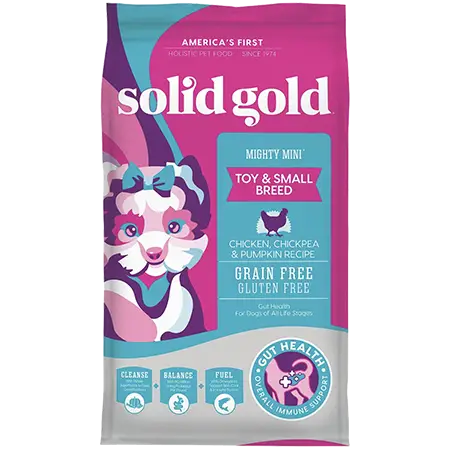
Best Toy-Breed Food – There aren’t many recipes out there specifically formulated for toy breeds, but this Solid Gold Mighty Mini Toy & Small Breed Dry Food recipe is one of the best commercial foods you can buy for dogs of this size. This recipe features real chicken as the main ingredient with grain-free carbohydrates like chickpeas and pumpkin. It contains no gluten or grains, and it comes in smaller kibbles perfectly sized for tiny mouths. This is a holistic recipe designed to nourish your dog’s body from the inside out, and it contains a long list of 20 superfoods to accomplish that goal.
- Pros: Formulated for toy breeds, grain-free recipe, includes 20 superfoods, small kibbles for tiny mouths, holistic recipe, no artificial additives or fillers, rich in omega fatty acids
- Cons: Somewhat expensive, some dogs are sensitive to chicken, contains some plant protein
Wellness CORE Grain-Free Small Breed Turkey & Chicken Dry Food
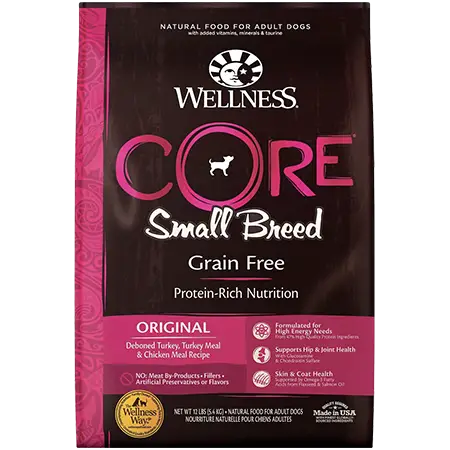
Best Small-Breed Food – When it comes to finding the best tasting foods dogs like the Wellness brand offers a wide variety of options including this recipe formulated for small breeds. In addition to being grain-free, this formula is rich in high-quality animal proteins like deboned turkey, turkey meal, and chicken meal with digestible carbohydrates like potatoes and peas. It contains plenty of healthy fats for energy as well as skin and coat support, plus fresh fruits and vegetables to provide natural sources for key nutrients. This recipe is also supplemented with dried fermentation products for probiotic support and chelated minerals.
- Pros: Formulated for small breeds, high-quality protein, rich in healthy fats for energy, grain-free recipe, supports skin and coat health, small kibble size, probiotics for digestion, chelated minerals
- Cons: Fairly expensive, some dogs are sensitive to poultry like chicken and turkey
Now Fresh Grain-Free Large Breed Turkey, Salmon, & Duck Dry Food
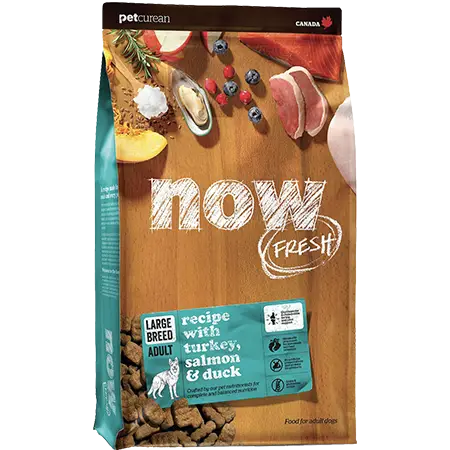
Best Large-Breed Dog Food – One of the best foods for large breeds is this Now Fresh Grain-Free Large Breed Dry Food. This product is specially formulated for large breeds, so it is rich in protein with moderate fat content and controlled levels of calcium and phosphorus. This recipe features 100% fresh turkey, salmon, and duck to provide 27% crude protein with plenty of healthy fats from flaxseed, canola oil, and coconut oil. It contains digestible grain-free carbohydrates like potatoes and peas as well as beneficial supplements like chelated minerals, prebiotic fibers, and dried fermentation products for probiotic support. It also contains several fresh fruits and vegetables as natural sources for key nutrients.
- Pros: Formulated for large breeds, rich in protein with moderate fat, several premium animal proteins, fresh fruits and vegetables, prebiotics and probiotics, chelated minerals, glucosamine, and chondroitin
- Cons: Main source of fat is plant-based (flaxseed), very expensive
Wellness Complete Health Deboned Chicken w/ Barley Senior Dry Food
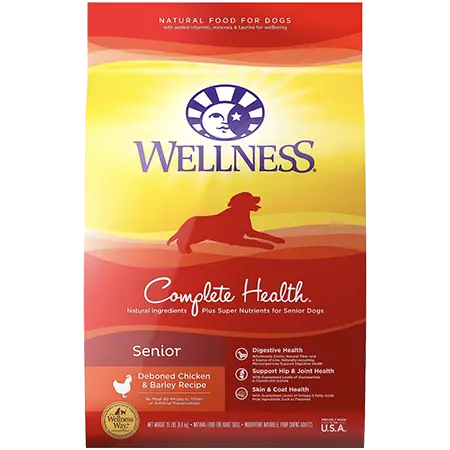
Best Senior Dog Food – As your dog gets older, his body and his metabolism will start to slow down which means that the food of his younger years may not work as well in his older years. This Wellness Complete Health Senior Dry Food is specially formulated to meet your senior dog’s nutritional needs, made with plenty of protein to support lean muscle mass with moderate fat content to prevent obesity. This recipe features high-quality proteins like deboned chicken with digestible carbohydrates like oatmeal and brown rice. It also features glucosamine and chondroitin for joint support as well as probiotics for healthy digestion.
- Pros: Formulated for senior dogs, high-quality protein for lean muscle mass, moderate fat to control calories, digestible carbohydrates, glucosamine and chondroitin for joints, probiotics for digestion.
- Cons: Some dogs are sensitive to chicken, first source of fat is plant-based (flaxseed)
Merrick Texas Beef w/ Sweet Potato Grain-Free Dog Food
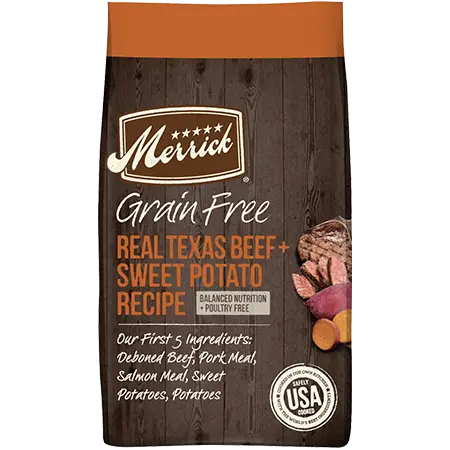
Best Grain-Free Dog Food – Whether your dog is sensitive to grains or not many dog owners agree that the best choice for food is a grain-free. Merrick Grain-Free Food comes in several flavor options, all made with digestible carbohydrates like sweet potatoes and peas. Each recipe features a premium protein like real chicken or beef, and they are formulated for all breeds and sizes. This grain-free food features healthy fats like chicken fat as well to provide your dog with essential fatty acids as well as skin and coat support. It also contains beneficial supplements like dried fermentation products and chelated minerals.
- Pros: Grain-free recipe, high-quality animal protein, fresh fruit for nutrients, rich in omega fatty acids, probiotics for digestion, chelated minerals, 38% crude protein and 17% fat
- Cons: Fairly expensive, some dogs are sensitive to chicken ingredients
Canidae PURE Lamb w/ Pea Limited Ingredient Dry Food
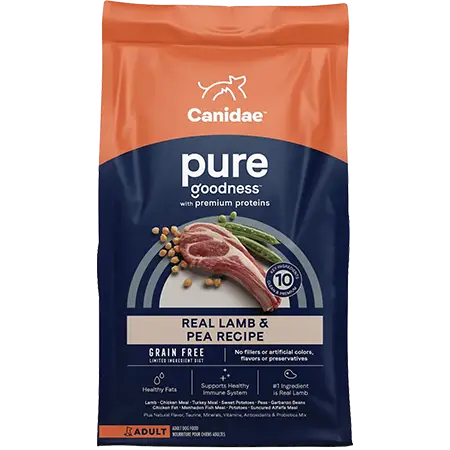
Best Limited Ingredient Dog Food – If you’re wondering what are the healthiest foods, limited ingredient diets should be included on the list. These dog foods are made with a lower number of main ingredients which reduces the risk for triggering food allergies and sensitivities. Canidae PURE Limited Ingredient Dry Food offers exceptional quality with multiple recipes to choose from, all with 10 main ingredients or fewer. The entire line of products is grain-free and made with premium proteins like lamb, bison, salmon, duck, and wild boar, most of which are novel proteins which further reduce the risk for food allergies.
- Pros: Made with fewer than 10 main ingredients, premium animal proteins, grain-free recipes, many recipes to choose from, highly digestible, chelated minerals, probiotics for digestion
- Cons: Very expensive to purchase
The Farmer’s Dog Beef Recipe
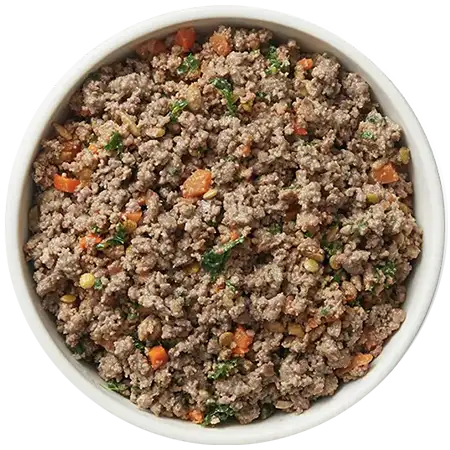
Best Human-Grade Dog Food – Another fresh pet food service, The Farmer’s Dog delivers fresh food right to your door. Easily some of the best dog food out there, The Farmer’s Dog’s fresh food comes in four different recipes which are sent in perfectly portioned packages according to your dog’s needs. You simply create a profile and choose a recipe then you’ll receive fresh, ready-to-serve meals that you can store in your fridge or freezer. In addition to sending the food, you’ll also receive a special scoop to help you measure out the precise amount as well as a lid to keep the food fresh in your fridge until feeding time.
- Pros: Fresh dog food delivered to your door, perfect portions catered to your dog’s needs, several recipes to choose from, automatic shipping for convenience
- Cons: Very expensive, only four set recipes to choose from
Castor & Pollux Organix Chicken & Sweet Potato Grain-Free Dog Food
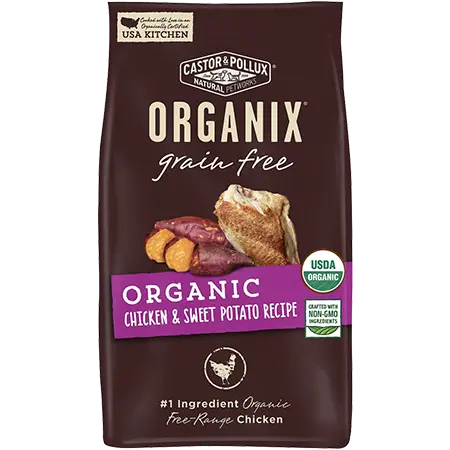
Best Organic Dog Food – Some of the best food to buy for a dog is made with organic ingredients like this Castor & Pollux Organix Grain-Free Food. This company offers a wide variety of original and grain-free recipes, all made with the highest-quality ingredients and prepared in organically certified USA kitchens. This particular recipe features organic, free-range chicken as a high-quality source of protein with organic sweet potatoes for carbohydrate support. It is loaded with fresh fruits and vegetables to provide natural sources for key nutrients as well as beneficial supplements like chelated minerals for balance.
- Pros: Made with organic ingredients in an organically certified USA kitchen, organic chicken as the main ingredient, rich in protein and healthy fats, fresh fruits and vegetables chelated minerals
- Cons: Fairly expensive, some dogs are sensitive to chicken ingredients, contains plant protein
Zignature Zssential Formula Grain-Free Wet Food
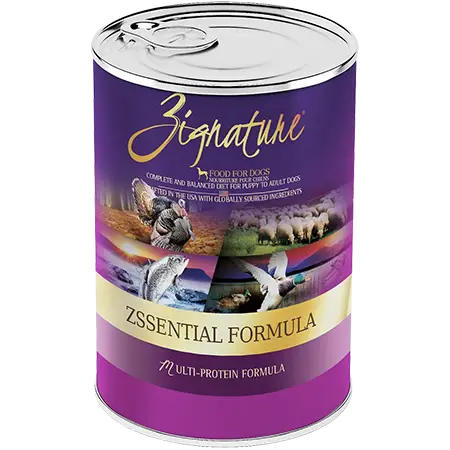
Best Wet Food – Sometimes the best dog food to buy for a dog is a wet food. If your dog prefers canned food, Zignature Zssential Formula is a great option. Made with a blend of premium animal proteins like turkey, duck, and lamb, this recipe is incredibly rich in protein while being low in saturated fat. It features grain-free carbohydrates like chickpeas and peas with turkey broth for both natural flavor and moisture. This recipe is also supplemented with essential nutrients including chelated minerals and contains fresh fruits and vegetables to provide natural sources for essential nutrients as well.
- Pros: Very high in protein, protein from numerous premium animal sources, grain-free digestible carbohydrates, fresh fruits and vegetables, chelated minerals
- Cons: Very expensive, some dogs are sensitive to poultry ingredients like turkey
The Honest Kitchen Whole Grain Chicken Dehydrated Dog Food
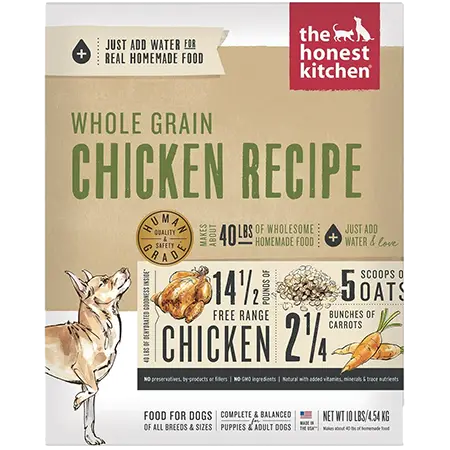
Best Dehydrated Dog Food – One of the best dog food options in terms of quality nutrition is dehydrated dog food. The Honest Kitchen specializes in dehydrated dog food, and they offer a variety of grain-free recipes made with premium ingredients like free-range chicken, sweet potatoes, and green beans. Because these recipes are dehydrated and not cooked, they retain most of their original nutritional integrity which means a more nutritious diet for your dog. All recipes are free from corn, wheat, and soy as well as GMO ingredients, by-products, and artificial additives. Plus, it is the first pet food made with 100% human-grade ingredients. Simply rehydrate with water or chicken broth then feed it to your dog.
- Pros: Made with 100% human-grade ingredients, retains most of its original nutritional integrity, dehydrated not cooked, grain-free recipes, no additives or low-quality ingredients
- Cons: Very expensive, some dogs don’t like the texture, must be rehydrated
Our 2023 Dog Feeding Guide:
Choosing the best dog food to buy for a dog is only half the battle. In addition to making a smart and healthy choice for your dog, you also need to know how much and how often to feed him, among other things. Here is a quick dog feeding guide to answer some common questions:
How much should I feed my dog?
There is no cut and dry answer to this question because dietary requirements vary from one dog to another. Though these differences are important to consider, it is also important to remember the importance of feeding your dog the right amount. If you feed him too little, you put him at risk for developing malnutrition or nutritional deficiencies. If you feed him too much, you increase his risk for obesity which also increases his risk for problems like heart disease, joint problems, and other diseases.
The best way to determine how much you should feed your dog is to consider his breed size, his age, and his body weight. As you may already know, toy and small breeds require a higher concentration of calories in their diet than larger breeds due to their fast metabolism. On the opposite end of the spectrum, you need to control the caloric intake of large and giant breeds to prevent them from growing too fast and to reduce their risk for obesity and musculoskeletal problems.
To make sure you feed your dog the right amount, start with a recipe formulated for dogs of his breed size. From there, refer to the feeding recommendations on the package according to your dog’s age and body weight. It is important to look at both the recommendations for the amount of food (generally measured in cups) as well as the calories. Different kibbles have different calorie contents, so make sure you follow the recommendations on the package for the exact food you are feeding your dog.
If you prefer to calculate your dog’s daily feeding amount based on calories, you’ll have to start by calculating his calorie needs. Generally speaking, the average adult dog needs about 30 calories per kilogram of bodyweight plus 70 to account for his daily activity. Here’s what that looks like:
30 x (weight in kg*) + 70 = daily calorie needs
*or body weight in pounds divided by 2.2
Keep in mind that this formula is for the average adult dog with a moderate activity level. Small and toy breeds may need as many as 40 calories per pound of bodyweight, and large and giant breeds (particularly inactive breeds) may need only 20 to 25 calories per pound. You can always talk to your veterinarian to help you determine your dog’s individual caloric requirements.
How often should I feed my dog?
If you look at the feeding recommendations on a dog food label, you’ll see a recommended amount measured in either cups, calories, or both. Remember, this is the recommended amount your dog should be eating for the entire day (unless otherwise stated). It is your job to determine how many meals a day your dog needs and then divide the total amount by that number.
Most dogs do well with two meals per day, so you will likely just need to divide your dog’s total daily recommendation in half. Toy and small breeds, however, may require an additional meal to provide a steady influx of energy for their fast metabolisms. The same may be true for active or working breeds. Medium, large, and giant breeds should be fed two meals per day, generally one in the morning and the second meal in the evening. You can, of course, adjust your dog’s feeding schedule to fit your own.
Should I feed my dog wet or dry food?
Again, there is no cut and dry answer to this question because every dog’s dietary requirements are slightly different. When it comes to choosing between wet dog food and dry kibble, there are numerous factors to consider. You must think about cost, convenience, quality, digestibility, and palatability. By comparing and contrasting these factors, you can make the right choice for your dog.
In terms of cost, dry food is generally the most cost-effective option based on serving size. Keep in mind, however, that the cost of dry food goes up with quality. If you’re feeding your dog a bottom-shelf product, it will be much cheaper than a top-shelf product. You should also consider the convenience factor. Dry food is more shelf-stable after the package has been opened and you have the option of filling your dog’s bowl with an entire day’s worth of food without worrying that it will go bad.
Quality is a major factor to consider with any dog food, wet or dry. The cost of either type of food will go up as you increase the quality. Digestibility is also a concern. If your dog has dental problems or certain health issues, wet food may be easier to eat and to digest because it is soft and because the moisture content is higher than for dry food. Dry food does, however, have the advantage of helping scrape plaque and tartar off your dog’s teeth and it is generally easy to digest as long as it is made from high-quality ingredients.
Palatability is an issue that can only be determined by your individual dog. Some wet foods are more similar to fresh food than kibble, but some dogs simply don’t like the texture. For other dogs, dry food is too difficult to chew or simply less palatable than wet food. You can always mix the two together or, if necessary, dampen dry food with water or chicken broth if necessary.
What ingredients should I avoid?
Dog food recipes are a dime a dozen, and it is your job as a dog owner to learn how to tell the good from the bad. While the best way to choose a high-quality food is to read the ingredients list, it’s just as important to pay attention to the ingredients that are NOT listed as the ingredients that ARE.
When it comes to the dog food ingredients you should avoid, there are some obvious things as well as some that are less so. Here’s a quick list of 10 dog food ingredients to avoid:
- Corn – Often used as a filler in low-quality foods, corn offers very limited nutritional value for dogs and also tends to be difficult to digest. It is also a common food allergen for dogs.
- Wheat – Though whole wheat is considered a healthy ingredient for humans, it offers low nutritional value for dogs and comes with a high risk for triggering food allergies and sensitivities. Wheat also contains gluten which can trigger a reaction in some dogs.
- By-Products – The word “by-product” should always raise a red flag because it usually indicates a lower quality ingredient. For example, chicken meal consists of fresh chicken that has been cooked and ground, making it a concentrated source of high-quality protein. Chicken by-product meal, however, could come from any number of chicken parts including feet, bones, necks, and undeveloped eggs. If you can’t tell where the ingredient comes from, it is best avoided.
- Chemicals – There are a wide variety of chemicals you might see listed for low-quality dog foods and they are generally easy to identify – they often have long, hyphenated names that leave you with no idea what they actually are. It is usually safe to assume, however, that they aren’t good.
- Preservatives – A preservative is used to increase the shelf-life of a dog food product, but there is a big difference between natural and artificial preservatives. Artificial preservatives like BHA and BHT are chemicals which can be very dangerous for dogs.
- Fillers – A filler is a low-quality ingredient that dog food companies use to add bulk to their products without significantly increasing their cost. Examples of fillers include things like soybean hulls, rice bran, oat hulls, and modified cornstarch.
- Food Dyes – Artificial coloring is never a beneficial ingredient in dog food because the only purpose it serves is to make the food look more appealing to humans. Food dyes like Red 40, Blue 2, and Yellow 5 should never appear in a high-quality dog food.
- Artificial Flavors – These ingredients are used to make the product more palatable for dogs which may seem like a benefit, but the inclusion of these ingredients generally points to a lower quality for the product as a whole.
- Sweeteners – There is no good reason for a food to include sweetener – the only benefit would be to make the product more palatable, but that is generally not as much of a concern with food for dogs as it is for human food.
- Rendered Fat – Healthy fat is an important part of a dog’s diet, but you want to avoid rendered fat. The best fat for dogs comes from identifiable animal or plant sources (such as chicken fat, salmon oil, or flaxseed). Rendered fats include things like animal digest, bone meal, and beef tallow. These fats are included to give the product flavor but don’t add nutritional value.
As a general rule, if you can’t tell what an ingredient is on a dog food label, you may want to avoid that product. Keep in mind that vitamin and mineral supplements may have chemical-sounding names, but anything with the word “by-product” attached is bad news, and anything with a long, unidentifiable name is probably a chemical.
How many cups are in a pound of dog food?
Though each dog food may be slightly different depending on the kibble size, you will generally get about 4 cups of food per pound.
Best Dog Food – Summary
If you want to feed your dog the best dog food possible, you need to understand the difference between a good food and a bad one.
Hopefully, by now, you’ve learned enough about your dog’s nutritional needs that you can look at a dog food label and know whether it is a high-quality product or not. Always look for animal protein as the first ingredient with digestible carbohydrates and healthy fats to follow.
In the end, the best food for your dog is one he will eat and one you can consistently afford. Your dog’s long-term health and wellness is well worth the cost to buy a quality dog food, so don’t skimp! If you need help finding the best dog food, try one of the recipes from the 15 best dog food reviews we have provided above.

